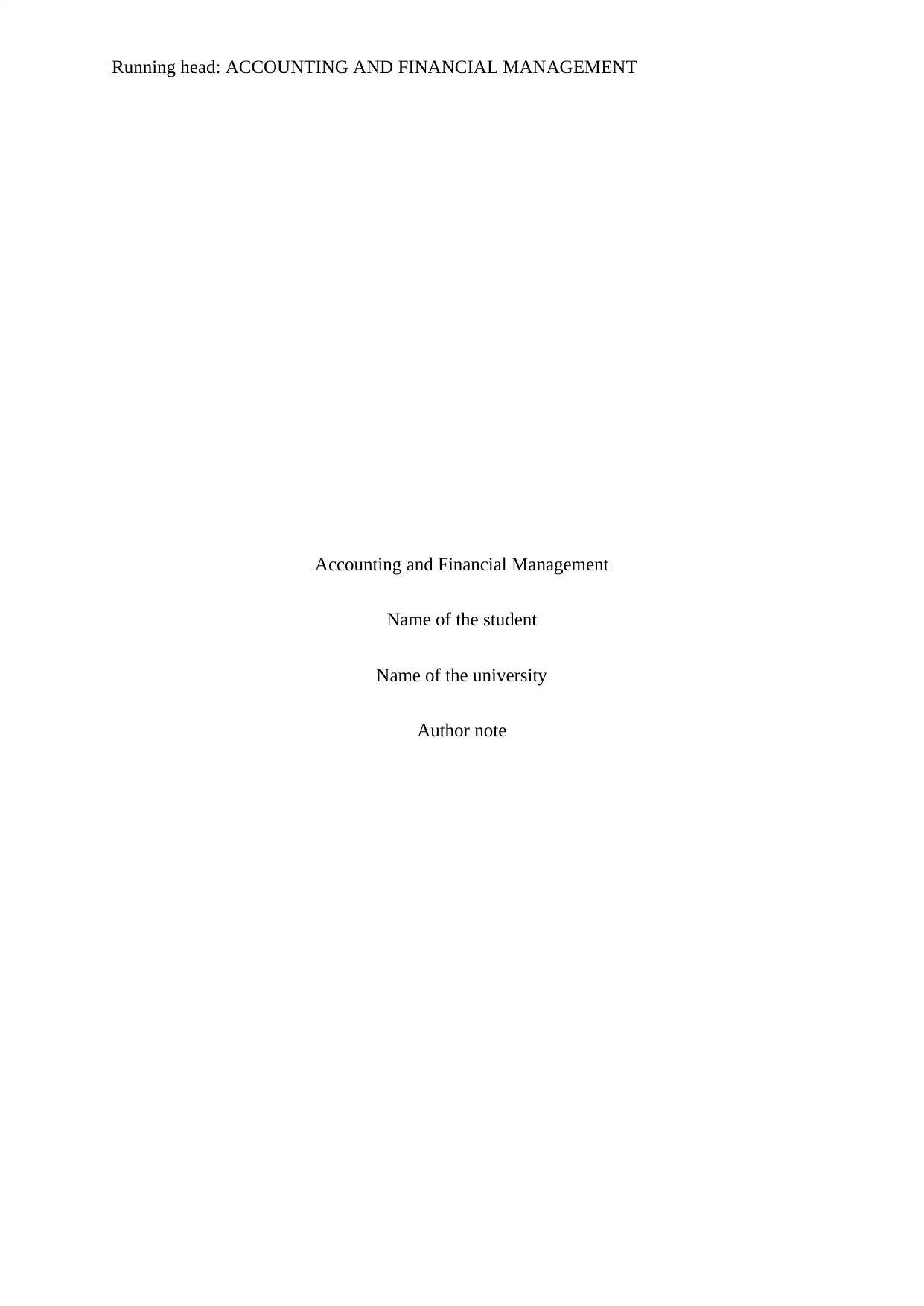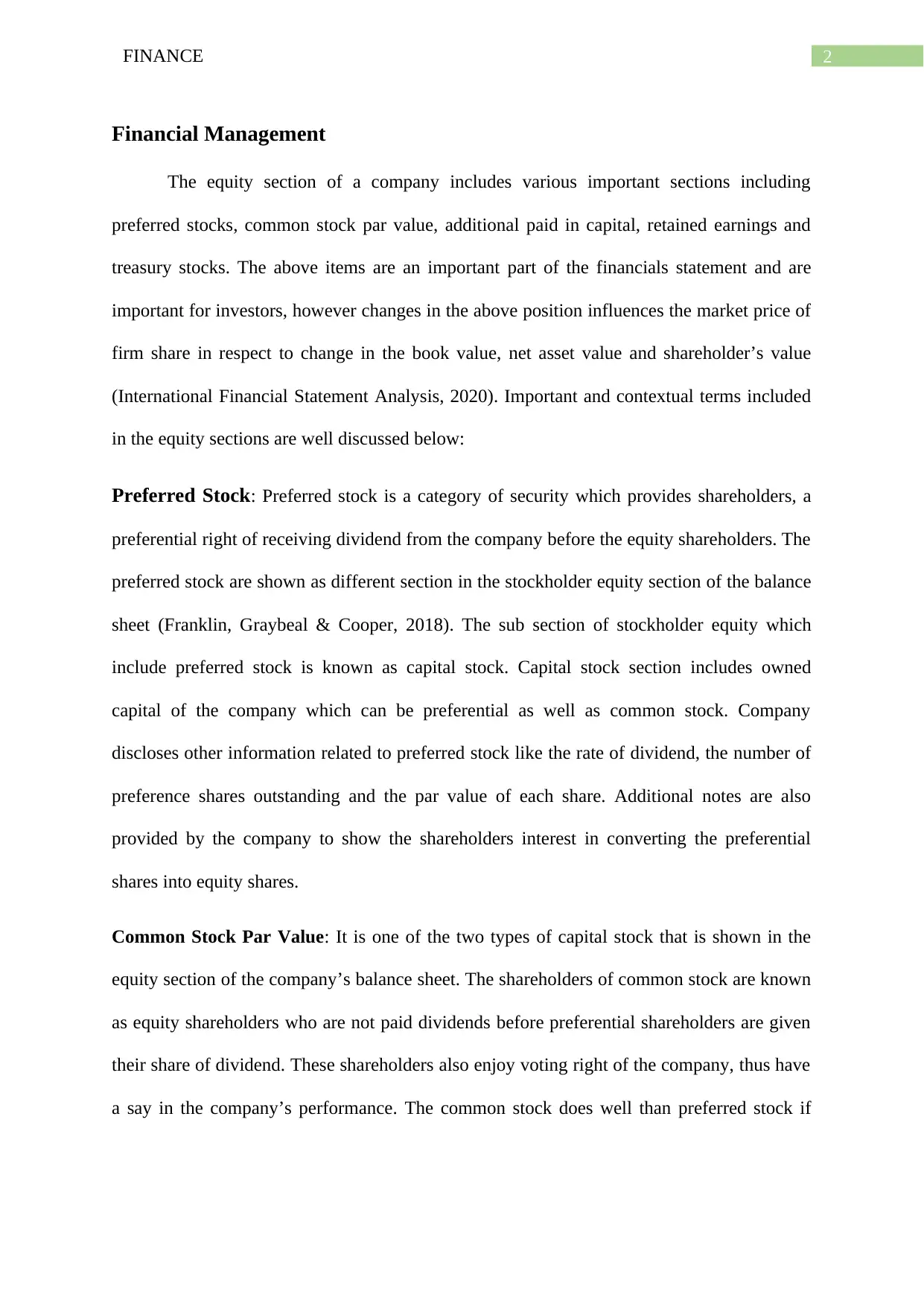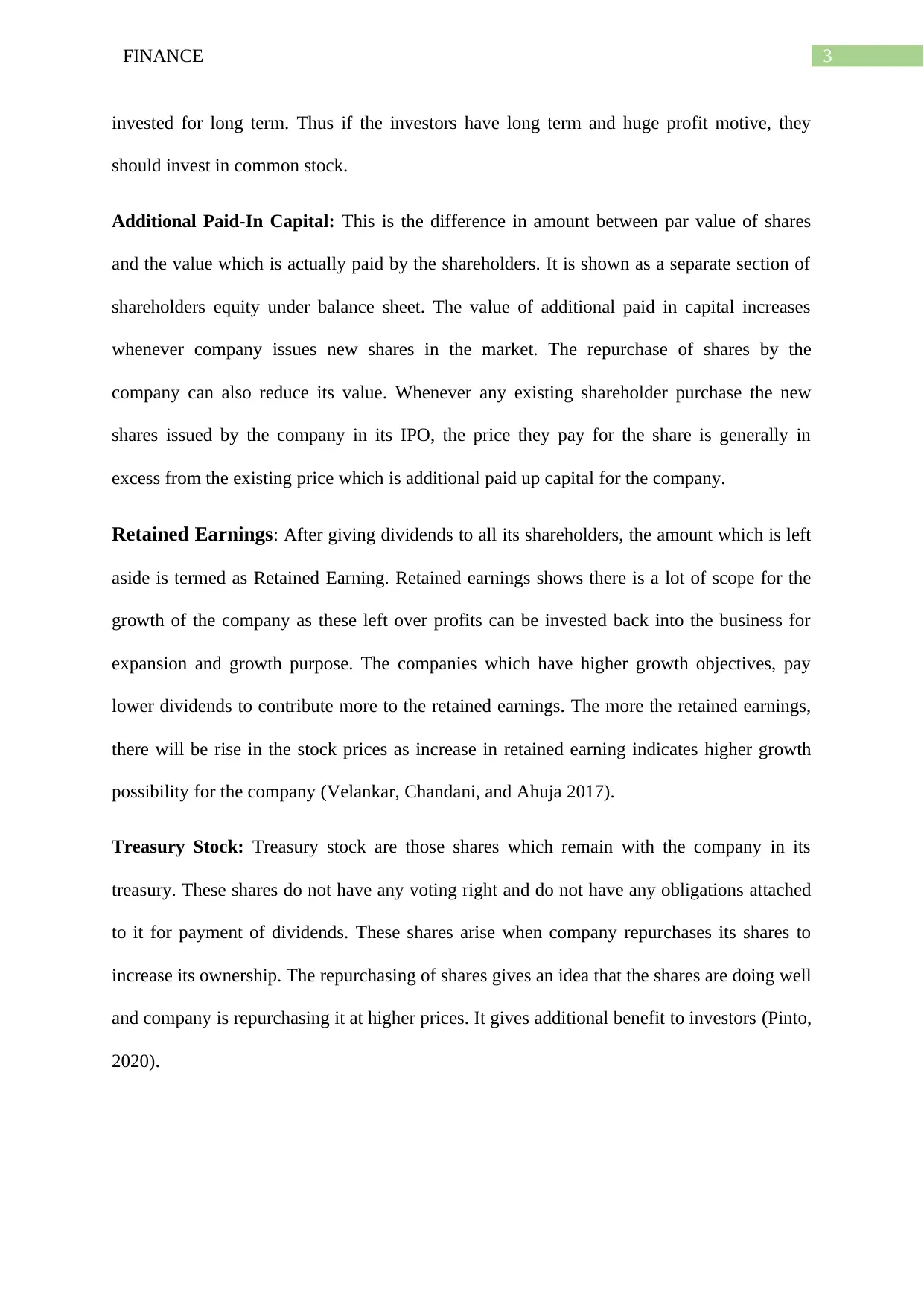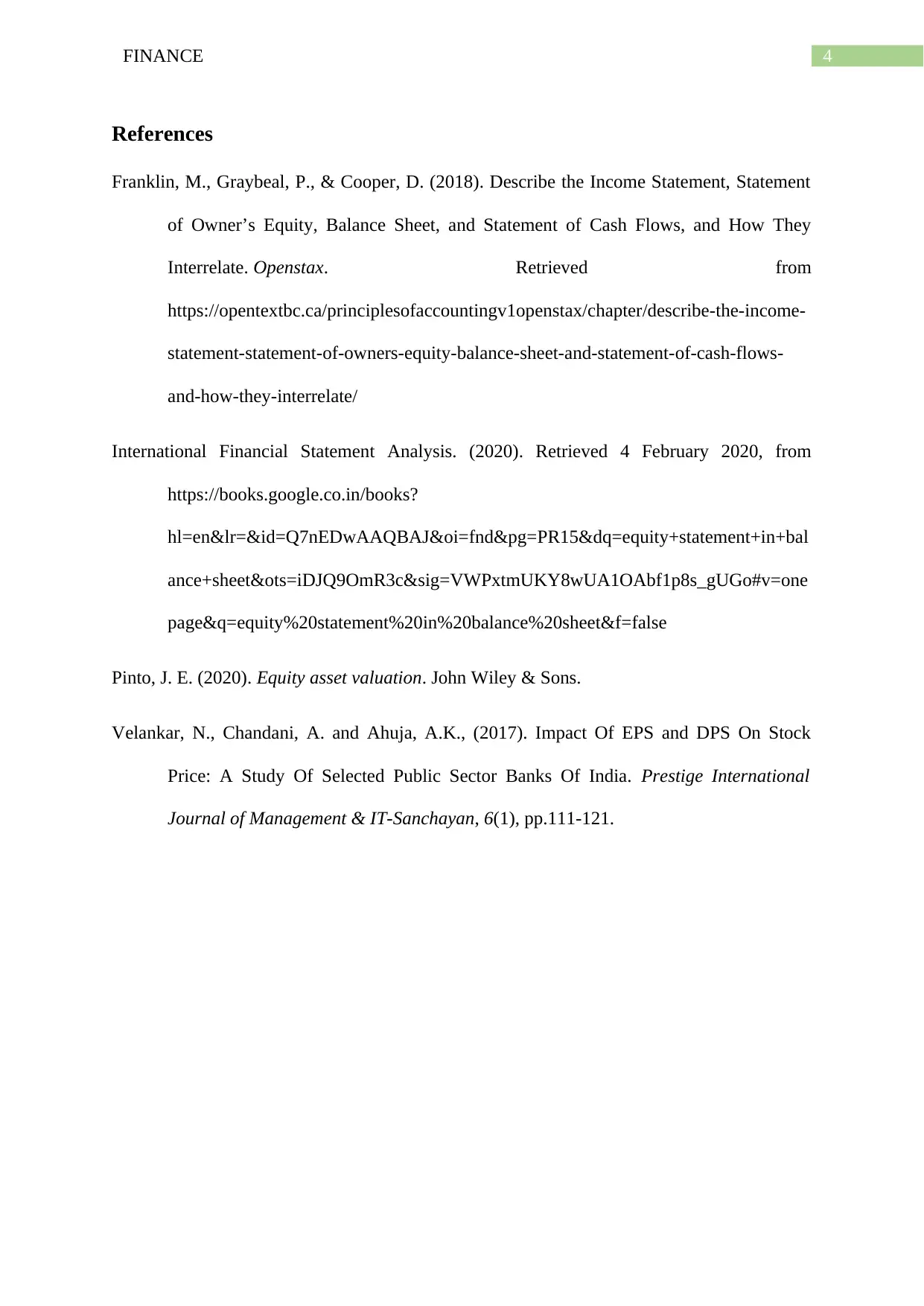Accounting and Financial Management: Equity Section Analysis
VerifiedAdded on 2022/08/17
|5
|863
|8
Report
AI Summary
This report provides an analysis of the equity section within a company's financial statements, a crucial component for investors. It delves into key elements such as preferred stock, detailing its preferential dividend rights, and the capital stock section where it resides. The report also examines common stock, outlining the rights of equity shareholders and its long-term investment potential. Furthermore, it explains additional paid-in capital, the difference between par value and the actual price paid by shareholders, and how it's affected by share issuances and repurchases. Retained earnings, the profits remaining after dividends, are discussed in terms of their significance for company growth and stock price increases. Lastly, the report covers treasury stock, shares repurchased by the company, and their implications for investors, including the absence of voting rights and dividend payments. The report references several financial resources to support its analysis.

Running head: ACCOUNTING AND FINANCIAL MANAGEMENT
Accounting and Financial Management
Name of the student
Name of the university
Author note
Accounting and Financial Management
Name of the student
Name of the university
Author note
Paraphrase This Document
Need a fresh take? Get an instant paraphrase of this document with our AI Paraphraser

1FINANCE
Table of Contents
Financial Management...............................................................................................................2
Preferred Stock.......................................................................................................................2
Retained Earnings..................................................................................................................3
References..................................................................................................................................4
Table of Contents
Financial Management...............................................................................................................2
Preferred Stock.......................................................................................................................2
Retained Earnings..................................................................................................................3
References..................................................................................................................................4

2FINANCE
Financial Management
The equity section of a company includes various important sections including
preferred stocks, common stock par value, additional paid in capital, retained earnings and
treasury stocks. The above items are an important part of the financials statement and are
important for investors, however changes in the above position influences the market price of
firm share in respect to change in the book value, net asset value and shareholder’s value
(International Financial Statement Analysis, 2020). Important and contextual terms included
in the equity sections are well discussed below:
Preferred Stock: Preferred stock is a category of security which provides shareholders, a
preferential right of receiving dividend from the company before the equity shareholders. The
preferred stock are shown as different section in the stockholder equity section of the balance
sheet (Franklin, Graybeal & Cooper, 2018). The sub section of stockholder equity which
include preferred stock is known as capital stock. Capital stock section includes owned
capital of the company which can be preferential as well as common stock. Company
discloses other information related to preferred stock like the rate of dividend, the number of
preference shares outstanding and the par value of each share. Additional notes are also
provided by the company to show the shareholders interest in converting the preferential
shares into equity shares.
Common Stock Par Value: It is one of the two types of capital stock that is shown in the
equity section of the company’s balance sheet. The shareholders of common stock are known
as equity shareholders who are not paid dividends before preferential shareholders are given
their share of dividend. These shareholders also enjoy voting right of the company, thus have
a say in the company’s performance. The common stock does well than preferred stock if
Financial Management
The equity section of a company includes various important sections including
preferred stocks, common stock par value, additional paid in capital, retained earnings and
treasury stocks. The above items are an important part of the financials statement and are
important for investors, however changes in the above position influences the market price of
firm share in respect to change in the book value, net asset value and shareholder’s value
(International Financial Statement Analysis, 2020). Important and contextual terms included
in the equity sections are well discussed below:
Preferred Stock: Preferred stock is a category of security which provides shareholders, a
preferential right of receiving dividend from the company before the equity shareholders. The
preferred stock are shown as different section in the stockholder equity section of the balance
sheet (Franklin, Graybeal & Cooper, 2018). The sub section of stockholder equity which
include preferred stock is known as capital stock. Capital stock section includes owned
capital of the company which can be preferential as well as common stock. Company
discloses other information related to preferred stock like the rate of dividend, the number of
preference shares outstanding and the par value of each share. Additional notes are also
provided by the company to show the shareholders interest in converting the preferential
shares into equity shares.
Common Stock Par Value: It is one of the two types of capital stock that is shown in the
equity section of the company’s balance sheet. The shareholders of common stock are known
as equity shareholders who are not paid dividends before preferential shareholders are given
their share of dividend. These shareholders also enjoy voting right of the company, thus have
a say in the company’s performance. The common stock does well than preferred stock if
⊘ This is a preview!⊘
Do you want full access?
Subscribe today to unlock all pages.

Trusted by 1+ million students worldwide

3FINANCE
invested for long term. Thus if the investors have long term and huge profit motive, they
should invest in common stock.
Additional Paid-In Capital: This is the difference in amount between par value of shares
and the value which is actually paid by the shareholders. It is shown as a separate section of
shareholders equity under balance sheet. The value of additional paid in capital increases
whenever company issues new shares in the market. The repurchase of shares by the
company can also reduce its value. Whenever any existing shareholder purchase the new
shares issued by the company in its IPO, the price they pay for the share is generally in
excess from the existing price which is additional paid up capital for the company.
Retained Earnings: After giving dividends to all its shareholders, the amount which is left
aside is termed as Retained Earning. Retained earnings shows there is a lot of scope for the
growth of the company as these left over profits can be invested back into the business for
expansion and growth purpose. The companies which have higher growth objectives, pay
lower dividends to contribute more to the retained earnings. The more the retained earnings,
there will be rise in the stock prices as increase in retained earning indicates higher growth
possibility for the company (Velankar, Chandani, and Ahuja 2017).
Treasury Stock: Treasury stock are those shares which remain with the company in its
treasury. These shares do not have any voting right and do not have any obligations attached
to it for payment of dividends. These shares arise when company repurchases its shares to
increase its ownership. The repurchasing of shares gives an idea that the shares are doing well
and company is repurchasing it at higher prices. It gives additional benefit to investors (Pinto,
2020).
invested for long term. Thus if the investors have long term and huge profit motive, they
should invest in common stock.
Additional Paid-In Capital: This is the difference in amount between par value of shares
and the value which is actually paid by the shareholders. It is shown as a separate section of
shareholders equity under balance sheet. The value of additional paid in capital increases
whenever company issues new shares in the market. The repurchase of shares by the
company can also reduce its value. Whenever any existing shareholder purchase the new
shares issued by the company in its IPO, the price they pay for the share is generally in
excess from the existing price which is additional paid up capital for the company.
Retained Earnings: After giving dividends to all its shareholders, the amount which is left
aside is termed as Retained Earning. Retained earnings shows there is a lot of scope for the
growth of the company as these left over profits can be invested back into the business for
expansion and growth purpose. The companies which have higher growth objectives, pay
lower dividends to contribute more to the retained earnings. The more the retained earnings,
there will be rise in the stock prices as increase in retained earning indicates higher growth
possibility for the company (Velankar, Chandani, and Ahuja 2017).
Treasury Stock: Treasury stock are those shares which remain with the company in its
treasury. These shares do not have any voting right and do not have any obligations attached
to it for payment of dividends. These shares arise when company repurchases its shares to
increase its ownership. The repurchasing of shares gives an idea that the shares are doing well
and company is repurchasing it at higher prices. It gives additional benefit to investors (Pinto,
2020).
Paraphrase This Document
Need a fresh take? Get an instant paraphrase of this document with our AI Paraphraser

4FINANCE
References
Franklin, M., Graybeal, P., & Cooper, D. (2018). Describe the Income Statement, Statement
of Owner’s Equity, Balance Sheet, and Statement of Cash Flows, and How They
Interrelate. Openstax. Retrieved from
https://opentextbc.ca/principlesofaccountingv1openstax/chapter/describe-the-income-
statement-statement-of-owners-equity-balance-sheet-and-statement-of-cash-flows-
and-how-they-interrelate/
International Financial Statement Analysis. (2020). Retrieved 4 February 2020, from
https://books.google.co.in/books?
hl=en&lr=&id=Q7nEDwAAQBAJ&oi=fnd&pg=PR15&dq=equity+statement+in+bal
ance+sheet&ots=iDJQ9OmR3c&sig=VWPxtmUKY8wUA1OAbf1p8s_gUGo#v=one
page&q=equity%20statement%20in%20balance%20sheet&f=false
Pinto, J. E. (2020). Equity asset valuation. John Wiley & Sons.
Velankar, N., Chandani, A. and Ahuja, A.K., (2017). Impact Of EPS and DPS On Stock
Price: A Study Of Selected Public Sector Banks Of India. Prestige International
Journal of Management & IT-Sanchayan, 6(1), pp.111-121.
References
Franklin, M., Graybeal, P., & Cooper, D. (2018). Describe the Income Statement, Statement
of Owner’s Equity, Balance Sheet, and Statement of Cash Flows, and How They
Interrelate. Openstax. Retrieved from
https://opentextbc.ca/principlesofaccountingv1openstax/chapter/describe-the-income-
statement-statement-of-owners-equity-balance-sheet-and-statement-of-cash-flows-
and-how-they-interrelate/
International Financial Statement Analysis. (2020). Retrieved 4 February 2020, from
https://books.google.co.in/books?
hl=en&lr=&id=Q7nEDwAAQBAJ&oi=fnd&pg=PR15&dq=equity+statement+in+bal
ance+sheet&ots=iDJQ9OmR3c&sig=VWPxtmUKY8wUA1OAbf1p8s_gUGo#v=one
page&q=equity%20statement%20in%20balance%20sheet&f=false
Pinto, J. E. (2020). Equity asset valuation. John Wiley & Sons.
Velankar, N., Chandani, A. and Ahuja, A.K., (2017). Impact Of EPS and DPS On Stock
Price: A Study Of Selected Public Sector Banks Of India. Prestige International
Journal of Management & IT-Sanchayan, 6(1), pp.111-121.
1 out of 5
Related Documents
Your All-in-One AI-Powered Toolkit for Academic Success.
+13062052269
info@desklib.com
Available 24*7 on WhatsApp / Email
![[object Object]](/_next/static/media/star-bottom.7253800d.svg)
Unlock your academic potential
Copyright © 2020–2025 A2Z Services. All Rights Reserved. Developed and managed by ZUCOL.





